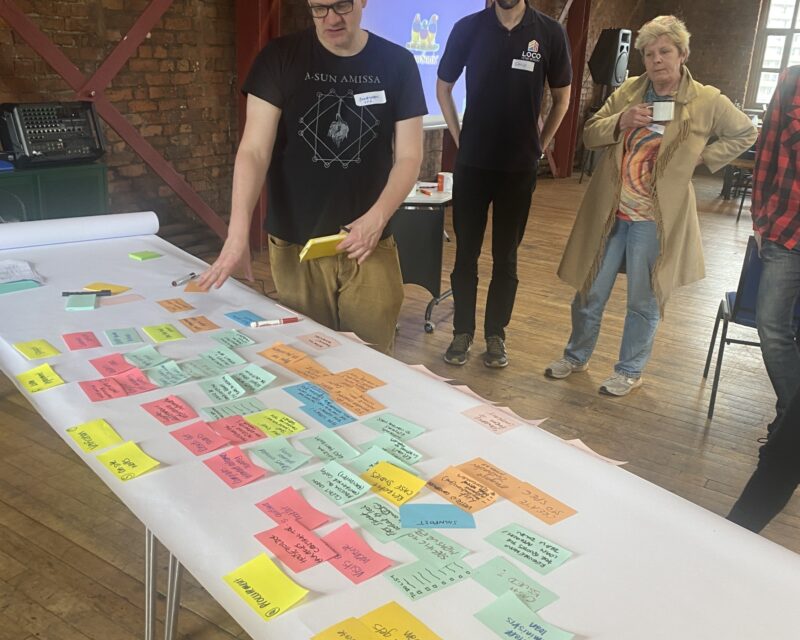Credit unions team up with retrofit one-stop shops for green home lending
From December 2023 to June 2025, a group of retrofit one-stop shops and credit unions collaborated on an innovative project to develop new green home loans.
The ‘A Credit Union One-Stop Shop for Retrofit and Finance’ project was part of the Green Home Finance Accelerator (GHFA) Pilot Phase programme. The project partners were:
People Powered Retrofit: A retrofit one-stop shop based in Manchester and serving the North West of England.
Metro Moneywise Credit Union: A payroll credit union based in Rochdale.
Carbon Co-op: A community energy co-operative based in Manchester.
The Association for British Credit Unions (ABCUL): The main trade association for credit unions in Britain.
Manchester Care and Repair: A home improvement agency and retrofit supply chain intermediary.
Julie Godefroy Associates: An expert sustainability consultant.
Loco Home Retrofit: A community retrofit one-stop shop based in Glasgow.
Partners also worked closely with South Manchester Credit Union and the SoundPound Group, who are a consortium of credit unions from across Greater Manchester.
Together, the partners developed two new loan products: the Better Home Loan, and a One-Stop Shop Loan.
Better Home Loan
The Better Home Loan is an ‘off-the shelf’ unsecured Credit Union loan, complete with integrated guidance materials, data collection and verification tools, and a suite of branded marketing materials.
Participating credit union staff can access training and support to promote home retrofit to their members and encourage best practice. During the pilot, in-person training was delivered by People Powered Retrofit and Carbon Co-op to the staff of Metro Moneywise Credit Union and South Manchester Credit Union. The partners also developed a retrofit eLearning course for the ABCUL Academy, which all ABCUL members will be able to access in future.

One Stop Shop Loan
The One-Stop Shop Loan is a type of bespoke loan product that can be accessed by retrofit one-stop shop clients. In our project, People Powered Retrofit partnered with South Manchester Credit Union to pilot this type of loan. The one-stop shop provides comprehensive advice and verification to their clients, and the credit union provides lending.

Key learnings from the projects
The ‘Credit Union One-Stop Shop for Retrofit and Finance’ project produced a huge amount of learning. Some of the key learning outcomes are summarised in this section. For more information, see the End of Pilot Phase Report.
Green home lending requires expert guidance and clear messaging
Market research carried out with credit union members found that many homeowner members have an interest in making green home improvements. They want to reduce their energy bills, make their cold homes warmer, and reduce their carbon footprint. The biggest barriers they face are finance, a lack of access to independent, trusted retrofit advice, and low confidence in their ability to find competent installers.
To tackle the lack of access to retrofit advice, project partners developed training for credit union staff and guidance materials for credit union members. Credit unions involved in the project learned more about retrofit; retrofit experts involved in the project learned about how to tailor advice and guidance to credit union members’ needs.
The retrofit experts also worked closely with credit unions on the marketing materials to accompany the Better Home Loan. They learned that clear messaging is key to convincing credit union members of the benefits of retrofit and to ensuring that their expectations are realistic - especially around the potential cost savings of different green home improvements.

Packages help make sense of retrofit options
Retrofit is a wide-ranging term that covers many different types of green home improvement - from renewables, to insulation, to ventilation. It can be challenging for credit unions and their members to understand the impact of different home improvements, what to do first, and how different improvements might interact with each other.
The project developed a ‘package’ approach to retrofit. Packages are a set of linked green home improvement measures that it makes sense to do together. For example, the Electricification package developed through this project included measures like upgrades to the consumer unit (fuse box), wiring upgrades, replacing appliances, installing an electric vehicle charge point, and/or installing solar PVs.
By packaging a range of home improvements together, it was easier for partners to develop targeted and appropriate guidance and support for credit unions and their members. Packages make it easier to communicate the benefits of retrofit, set expectations, and mitigate risks. Requirements for contractor selection, statutory approval and permission, and monitoring and verification are also made clearer when looking at a package of works rather than all of ‘retrofit’.
Credit union lending has potential to bridge gaps
Grant funding for retrofit exists across the UK. However, there are gaps in provision: this is where credit union lending has potential to be really transformative.
Credit union lending could help householders to fund enabling works. For example, under the Boiler Upgrade Scheme, householders in England and Wales can access a £7,500 grant to put towards an air- or ground-source heat pump. To access the grant, householders may need to do certain enabling works such as upgrading their radiators and/or pipework, topping up insulation, building cabinetry to house a hot water tank. These works are not covered by the Boiler Upgrade Scheme but are fundamental to householders ability to have an effective and efficient heat pump. By bridging the gap between government finance and the total cost of associated works, credit unions can support members to make green home improvements.
Another instance where credit union lending can bridge the gap is where government grants have delayed disbursement timelines. In Scotland, Capital Credit Union are offering bridging finance for retrofit via their supply chain partners. The loan covers the period between the work taking place and the government grant being disbursed to householders. It is repaid on receipt of the grant. For more about Capital Credit Union, see the Supply Chain Toolkit.
Verification is valuable; its implementation needs consideration
As part of this project, partners developed comprehensive data collection and verification methodologies. The aim of these methodologies is to equip credit unions with the data they need to understand the impact of the green home improvement loans that they issue. Data collection will help credit unions to confirm that loans have been spent on the green home improvements that members intended. It will also help credit unions to be able to quantify their impact on members’ health, wellbeing, and/or carbon emissions.
A challenge faced by partners was the fact that credit unions do not typically carry out extensive verification for unsecured loans. Partners worked together to ensure that verification methodologies were proportional and appropriate for credit union teams to implement.
Another challenge is the timeline of retrofit. The time between taking out a loan and the final installation can be weeks, months, or even years, depending on the chosen green home improvements. Credit unions need to consider how to collect data after installation, especially when the time between lending and installing is relatively long. The timeline of this project did not allow partners to pilot the post-installation data collection; partners intend to carry on with this work in future collaborations.
The future of credit union retrofit lending
Throughout this project, partners and the wider credit union sector have become more confident that credit unions have a role in delivering and expanding retrofit provision in the UK. 13 Credit Union green home loans are currently available across the UK (GFI, 2025). ABCUL have found that their members are highly interested in green home lending, and are shifting their strategy to ensure that green home lending is an ongoing part of their member support. In Greater Manchester, five members of the SoundPound Group have aligned with GFI’s Green Home Finance Principles.
To turn this nascent interest into action, credit unions need to be able to pool resources and present a unified voice. They need support from retrofit experts to deliver guidance to members, meet verification requirements, and understand the data that they are collecting - including the impact of retrofit on carbon emissions, health and comfort, and financial wellbeing.
Credit unions and their members benefit from the provision of independent, quality, joined-up retrofit advice for householders. Retrofit advice needs to be available and of a high standard.
Credit unions need consistent, clear, effective marketing campaigns to communicate the value of retrofit to their members and to bring new members on board.
Finally, credit unions would benefit greatly from government incentives and/or underwriting of loans. Some credit unions are already offering green home loans; government support would enable more credit unions to take up this type of loan product.
More information
